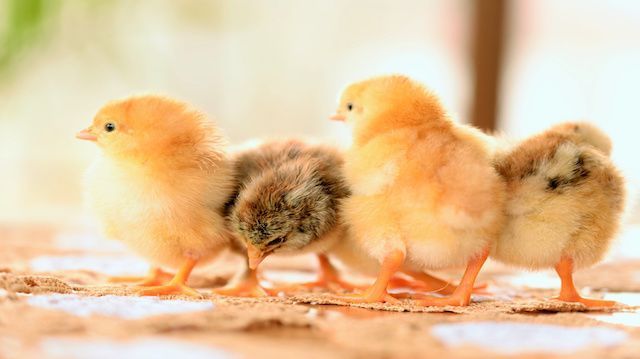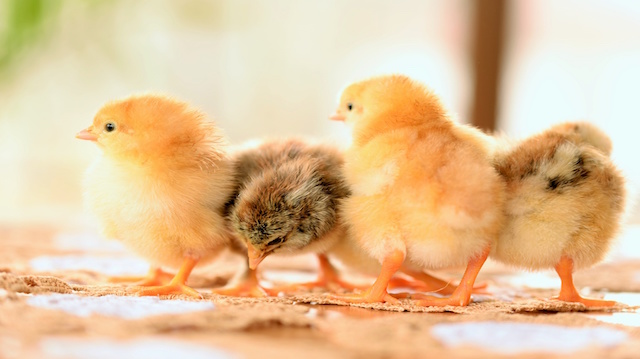
For poultry enthusiasts, the first signs of spring appear around February, when hatchery catalogs appear in their mailboxes or inboxes. Place an order, and in just a few short weeks, boxes of peeping chicks arrive for pickup at the post office.
Ordering chicks
For the first three days of a chick’s life, she is still digesting the nourishment from her yolk sac. This provides a safe window of time for hatcheries to send newborn chicks to their new homes; the birds don’t require feeding while they are in transit. Many hatcheries require a minimum order of 25 chicks, so that the birds can keep each other warm while traveling. Other hatcheries may add a few male chicks to smaller orders, at no charge, strictly for keeping the flock warm. If you don’t want that many chicks, see if you can find a friend or neighbor who would like to share the order. In warmer weather, hatcheries may agree to ship fewer chicks.
Ordering versus breeding chicks
If you keep hens in an urban or suburban area that doesn’t permit roosters, you have no choice but to purchase your chicks. Even if you do keep a rooster or two — roosters are good protection for a free-ranging flock — ordering chicks is usually a better bet than breeding them. If you let nature take its course, you’ll end up with approximately 50 percent male and 50 percent female chicks. Unless you raise cockerels for meat, you’ll have a lot of excess male chicks on hand. Too many males aren’t the only reason to think twice about breeding your own chickens. Here are some others:
- Some breeds of hens have had broodiness virtually bred out of them
- A broody hen might abandon her nest
- Broody hens stay pretty much in one place for three weeks, making them vulnerable to predators
When ordering chicks, you can opt solely for females. It’s very hard to sex newborn chicks, but hatcheries employ professional chick sexers to determine gender. Although a male chick or two may inevitably ship with a batch of females, odds are your chicks will arrive primarily as ordered.
Rare and heritage breeds
Farm supply stores may sell chicks in the late winter and early spring, and they are generally a good source for healthy birds. You can also purchase a brooder, chick starter, waterers and other necessities at the same time. However, these stores tend to sell only a few breeds popular among backyard chicken keepers. Rare and heritage breeds are available via mail order. Hatcheries often sell out so order these chicks as soon as they become available. If you are interested in showing chickens, you can order show-quality specimens through a hatchery.
Caring for chicks
No matter how they arrive at your home, chicks all need the same care if they aren’t raised by a hen. The crucial elements for successfully raising newborn chicks come down to the following:
Heat: Chicks need a safe heat source and a constant temperature between 90 and 95 degrees for their first week. A 150-watt incandescent bulb, safely attached, will do the trick.
Food: Feed your chicks commercial chick starter for the first two months. They should always have feed in their brooder.
Water: Have a chick waterer available at all times. Clean the waterer daily.
 As soon as your chicks arrive, place them in a brooder. You can buy a brooder or make one yourself. It’s basically a pen with a good heat source for chickens. The brooder should be large enough to provide at least one-half of a square foot per chick. Chicks may dehydrate somewhat during shipping so place each chick’s beak in the waterer when they arrive so they know where to drink. For best results, provide chicks in the brooder with at least two waterers.
As soon as your chicks arrive, place them in a brooder. You can buy a brooder or make one yourself. It’s basically a pen with a good heat source for chickens. The brooder should be large enough to provide at least one-half of a square foot per chick. Chicks may dehydrate somewhat during shipping so place each chick’s beak in the waterer when they arrive so they know where to drink. For best results, provide chicks in the brooder with at least two waterers.
Spread pine shavings on the floor of the brooder and place newspapers over them. The shavings soak up waste materials, and the newspapers, when removed and replaced once or twice a day, make cleanup easier. Put cardboard in the corners to protect chicks from drafts and to eliminate areas where chicks can get stuck or preyed upon by others. Keep a chick trough full of feed, but also throw feed onto the newspapers so food is easily available to all birds. You always want to avoid overcrowding in the brooder.
Tips
- Watch your chicks carefully on their first day. If they are crowded around the lamp or bulb, they are too cold. Replace the bulb with one of larger wattage.
- Never use halogen or fluorescent bulbs. They are designed for light, not heat.
- If the chicks are happily spread out around the brooder, the temperature is just right.
Growing up
As the chicks get older, you can lower the temperature in the brooder by about five degrees each week. When the outside temperature is about the same as the brooder temperature, you can move the chicks to a secure outdoor coop. At about six weeks of age, most chicks have feathers, so they can probably survive outdoors, but it’s best to wait until they are eight weeks old. That’s especially true if your region experiences a cold spring. At about eight weeks, start transitioning them to a commercial starter ration. Expect your pullets to begin laying eggs at about the age of six months, although the exact time varies by breed.
Keeping chickens can be an extremely rewarding endeavor. With minimal effort you can enjoy your own eggs and meat, raised ethically on the diet you select. Great for backyards and farms alike, these cute little chicks will grow to be hens that provide for you all year!
—Jane Meggitt
Jane Meggitt graduated from New York University and worked as a staff writer for a major New Jersey newspaper chain. Her work on pets, equines and health have appeared in dozens of publications, including The Daily Puppy, The Nest Pets, Horse News, Hoof Beats and Horseback magazines.
Sources:
http://www.almanac.com/blog/raising-chickens/raising-chickens-101-bring-baby-chicks
http://www.backyardchickens.com/a/chicken-tractors-mobile-chicken-coop-designs
http://www.motherearthnews.com/homesteading-and-livestock/poultry/poultry-feed-zmaz10fmzraw.aspx

